What to be on the lookout for…
Phytopthora Blight
Brief periods of heavy rain towards the end of last week caused some farms to experience flooding, particularly in low spots of the field. On a farm with a known history of long-lived spores of the water mold Phytophthora capsici, soils saturated for several hours during relatively warm (75°F-85°F), created an opportune environment for the water mold to spread quickly. During a field scout, we noticed wilted yellow summer squash and pumpkin plants. Some entire plants had already collapsed, while others had some rigid stems remaining with lots of fruit rot.
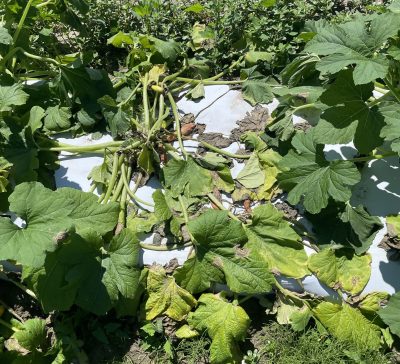
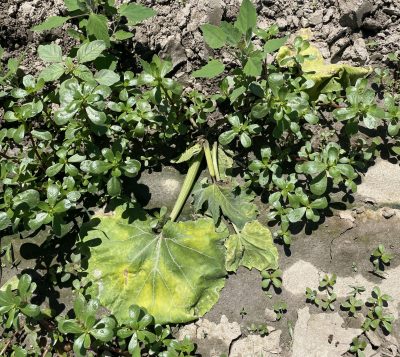
P. capsici cannot be managed by fungicide applications alone. Successful disease control is achieved only by a season-long effort to manage water and other cultural practices. The single most effective way to control this disease is to prevent its movement into clean fields. Spores can spread through soil that clings to tires or field equipment, humans transporting infected plant material on clothes or boots, and infested surface or irrigation water. Plant susceptible crops like tomatoes, peppers, eggplant, and all cucurbit species in fields that have no history of the disease and in well-draining soils. Plant non-vining crops on raised beds, avoid planting in low areas where water puddles, and improve drainage by sub-soiling after heavy rain events. You can do this by promptly disking under small areas where the disease appears along with a border of healthy appearing plants. Avoid working in wet fields and compacting the soil. Biofumigate the infested field with a mustard cover crop.
A preventative strategy is needed to ensure effective control in fields with the history of Phytopthora. Alternate among targeted fungicides to manage resistance. Consult the New England Vegetable Management Guide for spray options for cucumbers or pumpkins and squash.
Cucurbit Downy Mildew (CDM): Risk Remains High in CT
For growers who have yet to see CDM in their fields, Connecticut remains at a high risk. A second farm confirmed DM on their cucumbers as of July 15th. Targeted fungicides include Orondis Opti (M05, 49), Previcur Flex (28), Ranman (21), Zing! (22, M05). For organic options, LifeGard, Serenade, and Double Nickel are labeled.
For more detailed information on downy mildew and management options for conventional and organic systems, see the resources below:
Mobile Fungicides for Managing Three Major Cucurbit Diseases
Biopesticides for Managing Cucurbit Downy Mildew Organically
Squash Bugs
If you grow summer squash and zucchini, it’s likely you have seen squash bug populations increase in recent weeks. Squash bugs also favor Hubbard squash and pumpkin crops. They thrive when plants are large and can provide a greater surface area for food, shelter, and egg-laying. Adults are long-lived and lay eggs over several weeks. High densities of squash bugs can cause foliage to wilt, turn black, and die. Squash bugs also feed on the fruit causing scarring and reducing marketability. Scout undersides of leaves for squash bug adults and eggs. Treat if egg masses exceed 1 per plant. Time squash bug sprays to kill young nympths which are easiest to control. Thorough coverage is necessary. As this often coincides with bloom period, treat late in the day to reduce risk to bees and select products with lower bee toxicity.
See squash management options in the New England Vegetable Management Guide.
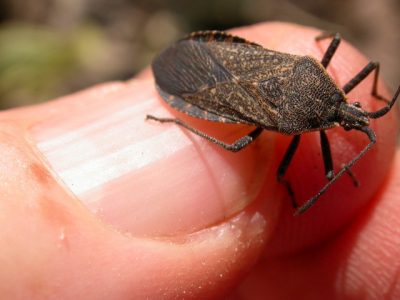
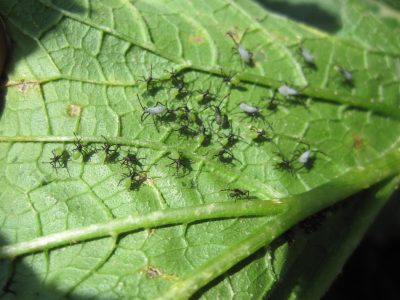
Photo: UMass Extension.
Sweet Corn Pests - Trap Count Update
| Location | CEW (avg per night) | ECB - NY | ECB - IA | ECB - III | FAW |
| Glastonbury A | 0 | 0 | 0 | 0 | 0 |
| Glastonbury B | 1.5 | 5 | 0 | 0 | 0 |
| Berlin | .5 | 1 | 1 | 0 | - |
| Shelton | 1 | 1 | 0 | 0 | 0 |
Note: We caught wainscot moths in FAW traps and spongy moths in ECB traps. Accurate ID of moths in traps is important. View our Sweet Corn Pest ID Guide.
Squash Vine Borer Trap Count (Berlin): 18
Spray intervals for CEW can be found on our website. See the New England Vegetable Management Guide for management strategies for all sweet corn insect pests.
Resource: Managing Flood Risks on Farms
Our team at UConn Extension has put together a factsheet to help you navigate flood risks on your farm. From preparing before a big storm to dealing with the aftermath, this short guide covers practical steps to help protect your crops, soil, and equipment. With more extreme weather events happening across the region, it's a good time to think about how to reduce damage and recover safely if flooding occurs.
Read the factsheet: Managing Flood Risks on Farms
Additional State Resources:
Continue to be on the lookout for...
Striped and Spotted Cucumber Beetles
Flea Beetles: Brassica and Solanaceous
Want the New England Vegetable Management Guide and/or Northeast Vegetable and Strawberry Pest ID Guide at your fingertips?
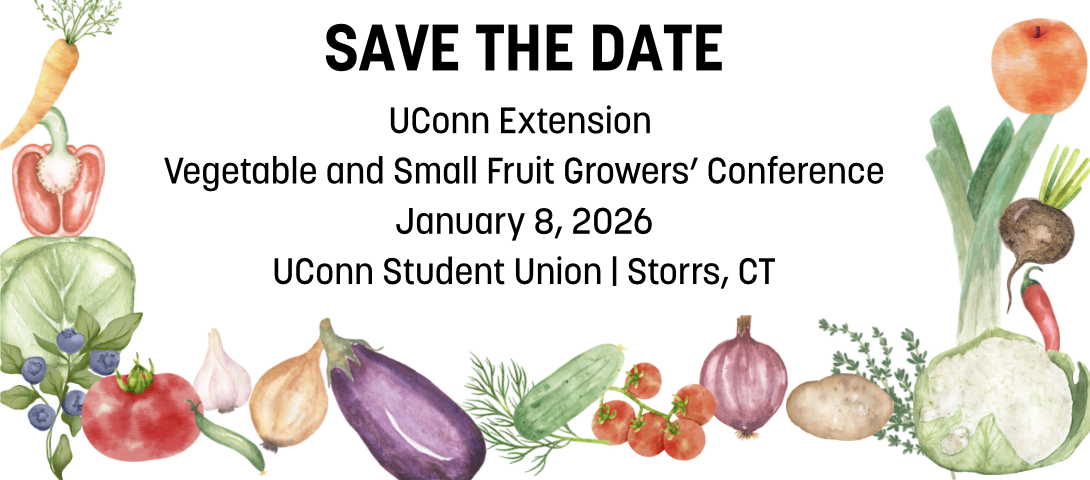
The Connecticut Agricultural Experiment Station’s Plant Science Day is held at Lockwood Farm on the first Wednesday of August every year, beginning in 1910. This one-day event features reports on research, field plots, barn exhibits, tours, and other opportunities for Connecticut residents and attendees to discuss many topics of plant science on an informal basis and interact with CAES scientists and staff.
The Day’s Events Include:
- Barn Exhibits
- Field Plots
- Technical Demonstrations
- Plant Diagnosis and Plant Identification
- Insect Identification
- Questions Answered
- Activities for Kids
- Lockwood Farm Walking Tour
- All About Apples Walking Tour
Stay in touch with us
- Share what you see: We're here to assist with identification, management strategies, and guidance on best practices. Send us a photo/message via text at 959-929-1031.
- Facebook Group: UConn Extension moderates a private Facebook group specifically for commercial vegetable producers. It is a space to share photos of insects and diseases you find in your fields, ask questions, share ideas, and stay engaged with growers across the state. Join the "UConn Extension - Vegetable IPM" Facebook Group
- Schedule a consultation: Would you benefit from meeting with an Extension Specialist at your farm to provide insight on pest or disease identification, management strategies, and more? If so, please contact our Vegetable Extension Specialist, Shuresh Ghimire, to setup a farm visit. Contact him at shuresh.ghimire@uconn.edu or 860-870-6933.
Contact Information
Shuresh Ghimire, Vegetable Extension Specialist: shuresh.ghimire@uconn.edu
Nicole Davidow, Vegetable Extension Outreach Assistant: nicole.davidow@uconn.edu
Vegetable IPM Office Phone Number:
860-870-6933
Vegetable IPM Cell Phone Number:
959-929-1031 (feel free to text/iMessage photos)
Vegetable IPM Pest Alert Audio Recording:
860-870-6954
Thank you for reading!
This report was prepared by Nicole Davidow, Outreach Assistant, and Shuresh Ghimire, Commercial Vegetable Specialist, UConn Extension.

The information in this document is for educational purposes only. Any reference to commercial products, trade or brand names is for information only, and no endorsement or approval is intended. Always read the label before using any pesticide. The label is the legal document for product use. Disregard any information in this report if it is in conflict with the label. UConn Extension does not guarantee or warrant the standard of any product referenced or imply approval of the product to the exclusion of others which also may be available. The University of Connecticut, UConn Extension, College of Agriculture, Health and Natural Resources is an equal opportunity program provider.

